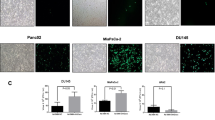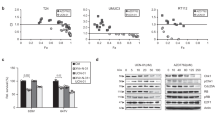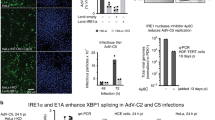Abstract
Induction of apoptosis by adenovirus E1A in rodent cells is stimulated by wild type (wt) p53 but completely suppressed by mutated p53. The suppression is overcome by coexpression with Id proteins (Ids). The cells expressing E1A and Ids undergo apoptosis after accumulation in S phase, suggesting that S phase events are perturbed by E1A and Ids. The E1A domains required for induction of apoptosis, analysed by transfection with expression vectors for E1A, Ids and their mutants, followed by flow cytometry, reside in N-terminal (positions 17 – 38), CR1 and CR2 regions. Interaction of E1A with Ids requires the N-terminal and CR1 regions. The cyclin D1 promoter activity in S phase was reduced severely by E1A and this reduction is caused through CR1 and CR2 regions required for interaction with pRB. Analysis of DNA synthesis in G2/M arrested cells indicated that E1A is capable of inducing >4 N cells and this E1A-mediated DNA rereplication is enhanced by coexpression with Id-1H. The E1A domains required for induction of DNA rereplication coincide with those required for apoptosis.
This is a preview of subscription content, access via your institution
Access options
Subscribe to this journal
Receive 50 print issues and online access
$259.00 per year
only $5.18 per issue
Buy this article
- Purchase on Springer Link
- Instant access to full article PDF
Prices may be subject to local taxes which are calculated during checkout









Similar content being viewed by others
References
Bunz F, Dutriaux A, Lengauer C, Waldman T, Zhou S, Brown JP, Sedivy JM, Kinzler KW and Vogelstein B. . 1998 Science 282: 1497–1501.
Canman CE, Gilmer TM, Coutts SB and Kastan MB. . 1995 Genes Dev. 9: 600–611.
Chen C and Okayama H. . 1987 Mol. Cell. Biol. 7: 2745–2752.
Chomczynski P and Sacchi N. . 1987 Anal. Biochem. 162: 156–159.
Cox LS. . 1997 Trends Cell Biol. 7: 493–498.
Debbas M and White E. . 1993 Genes Dev. 7: 546–554.
Di Leonardo A, Khan SH, Linke SP, Greco V, Seidita G and Wahl GM. . 1997 Cancer Res. 57: 1013–1019.
Dyson N, Howley PM, Munger K and Harlow E. . 1989 Science 243: 934–987.
El-Deiry WS, Tokino T, Velculescu VE, Levy DB, Parsons R, Trent JM, Lin D, Mercer WE, Kinzler KW and Vogelstein B. . 1993 Cell 75: 817–825.
Florio M, Hernandez MC, Yang H, Shu HK, Cleveland JL and Israel MA. . 1998 Mol. Cell. Biol. 18: 5435–5444.
Freeman RS, Estus S and Johnson EJ. . 1994 Neuron 12: 343–355.
Gunning P, Leavitt J, Muscat G, Ng S-Y and Kedes L. . 1987 Proc. Natl. Acad. Sci. USA 84: 4831–4835.
Hall PA, Kearsey JM, Coates PJ, Norman DG, Warbrick E and Cox LS. . 1995 Oncogene 10: 2427–2433.
Ishii T, Shimizu M, Kanayama Y, Nakada S, Nojima H and Oda K. . 1993 Exp. Cell Res. 208: 407–414.
Kastan MB, Zhan Q, El-Deiry WS, Carrier F, Jacks T, Walsh WV, Plunkett BS, Vogelstein B and Fornace Jr AJ. . 1992 Cell 71: 587–597.
Kimura G, Itagaki A and Summers J. . 1975 Int. J. Cancer 15: 694–706.
Kranenburg O, van der Eb Aj and Zantema A. . 1996 EMBO J. 15: 46–54.
Lahti JM, Li H and Kidd VJ. . 1997 J. Biol. Chem. 272: 10859–10869.
Lasorella A, Iavarone A and Israel MA. . 1996 Mol. Cell. Biol. 16: 2570–2578.
Lowe SW and Ruley HE. . 1993 Genes Dev. 7: 535–545.
Matsuoka S, Yamaguchi M and Matsukage A. . 1994 J. Biol. Chem. 269: 11030–11036.
Muller H, Lukas J, Schneider A, Warthoe P, Bartek J, Eilers M and Strauss M. . 1994 Proc. Natl. Acad. Sci. USA 91: 2945–2949.
Mymryk JS, Shire K and Bayley ST. . 1994 Oncogene 9: 1187–1193.
Nakajima T, Ohi N, Arai T, Nozaki N, Kikuchi A and Oda K. . 1995 Oncogene 10: 651–662.
Nakajima T, Yageta M, Shiotsu K, Morita K, Suzuki M, Tomooka Y and Oda K. . 1998 Proc. Natl. Acad. Sci. USA 95: 10590–10595.
Norton JD, Deed RW, Craggs G and Sablitzky F. . 1998 Trends Cell Biol. 8: 58–65.
Notterman D, Young S, Wainger B and Levine AJ. . 1998 Oncogene 17: 2743–2751.
Philipp A, Schneider A, Vasrik I, Finke K, Xiong Y, Beach D, Alitalo K and Eilers M. . 1994 Mol. Cell. Biol. 14: 4032–4043.
Prabhu S, Ignatova A, Park ST and Sun XH. . 1997 Mol. Cell. Biol. 17: 5888–5896.
Shikama N, Lyon J and La Thangue NB. . 1997 Trends Cell Biol. 7: 230–236.
Smith ML, Chen IT, Zhan Q, Bae I, Chen CY, Gilmer TM, Kastan MB, O'Connor PM and Fornace Jr AJ. . 1994 Science 266: 1376–1380.
Sofer LY and Resnitzky D. . 1996 Oncogene 13: 2431–2437.
Tanaka K, Pracyk JB, Takeda K, Yu ZX, Ferrans VJ, Deshpande SS, Ozaki M, Hwang PM, Lowenstein CJ, Irani K and Finkel T. . 1998 J. Biol. Chem. 273: 25922–25928.
Tsunoda H, Terasawa T, Yageta M, Nakajima T, Tomooka Y, Tsuchida N and Oda K. . 1999 Biochem. Biophys. Res. Commun. 255: 722–730.
White E, Cipriani R, Sabbatini P and Denton A. . 1991 J. Virol. 65: 2968–2978.
Xiong Y, Zhang H and Beach D. . 1992 Cell 71: 505–514.
Xu J and Morris GF. . 1999 Mol. Cell. Biol. 19: 12–20.
Zhu L, van den Heuvel S, Helin K, Fattaey A, Ewen M, Livingston D, Dyson N and Harlow E. . 1993 Genes Dev. 7: 1111–1125.
Acknowledgements
We thank Dr E Harlow for the expression vectors for E1A mutants, NCdl, dl646N and dl922/947 and pCMVCD20, Dr M Kanzaki for pMEP4-CD20 and Drs S Kitazawa and G Peters for cyclin D1 promoter-luciferase constructs. This work is supported by special coordination funds of the Science and Technology Agency of the Japanese Government.
Author information
Authors and Affiliations
Rights and permissions
About this article
Cite this article
Yageta, M., Tsunoda, H., Yamanaka, T. et al. The adenovirus E1A domains required for induction of DNA rereplication in G2/M arrested cells coincide with those required for apoptosis. Oncogene 18, 4767–4776 (1999). https://doi.org/10.1038/sj.onc.1203063
Received:
Revised:
Accepted:
Published:
Issue Date:
DOI: https://doi.org/10.1038/sj.onc.1203063
Keywords
This article is cited by
-
ID1 affects the efficacy of radiotherapy in glioblastoma through inhibition of DNA repair pathways
Medical Oncology (2013)
-
E1A oncogene expression inhibits PTHrP P3 promoter activity and sensitizes human prostate cancer cells to TNF-induced apoptosis
International Urology and Nephrology (2010)
-
Adenovirus E1a protein enhances the cytotoxic effects of the herpes thymidine kinase-ganciclovir system
Cancer Gene Therapy (2003)
-
P130 and its truncated form mediate p53-induced cell cycle arrest inRb−/− Saos2 cells
Oncogene (2002)



